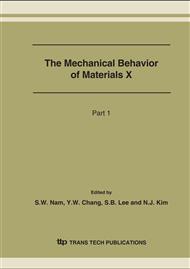p.989
p.995
p.999
p.1003
p.1007
p.1011
p.1015
p.1019
p.1023
Effects of High Temperature Gas Environments(H2, Pure Air, Ar, Vacuum) on Slow Strain Rate Tensile Properties at 700°C of TiAl Alloy
Abstract:
Tensile test of TiAl alloy was carried out in 700oC gas environment(H2, pure air, Ar, vacuum) at three strain rates, 2.8x10-4, 2.8x10-5, and 2.8x10-6s-1. With decreasing strain rate, the ultimate tensile strength decreased in all environments similarly. However, elongation to fracture differed from each environment. With decreasing strain rate, the elongation to fracture in vacuum and Ar increased slightly, that in H2 increased much and that in pure air significantly. The reasons of such behaviour are not known. One of the reasons for high elongation to fracture would be formation of multiple microcracks in H2 and pure air on the gauge surface of the specimen during tensile deformation.
Info:
Periodical:
Pages:
1007-1010
Citation:
Online since:
August 2007
Authors:
Price:
Сopyright:
© 2007 Trans Tech Publications Ltd. All Rights Reserved
Share:
Citation:


